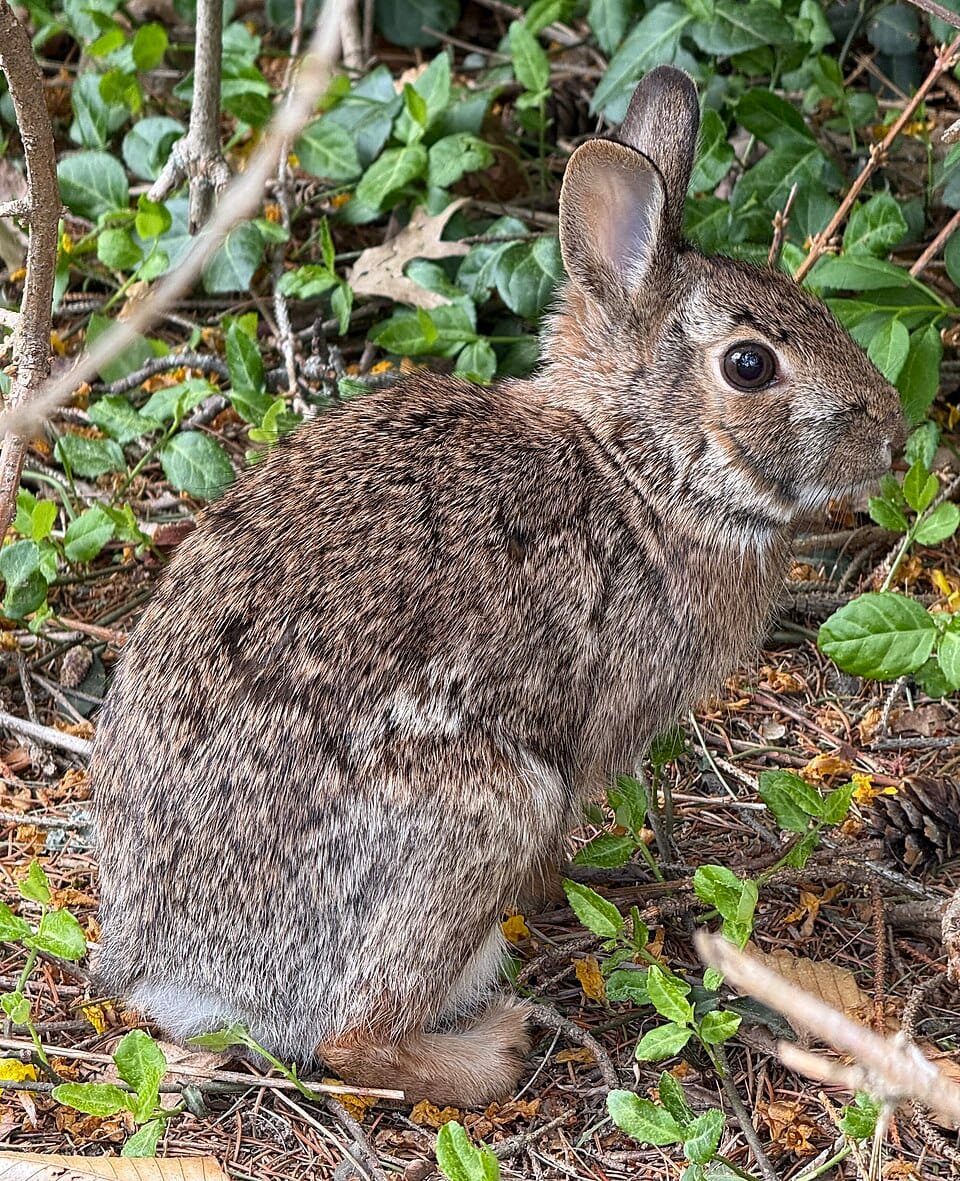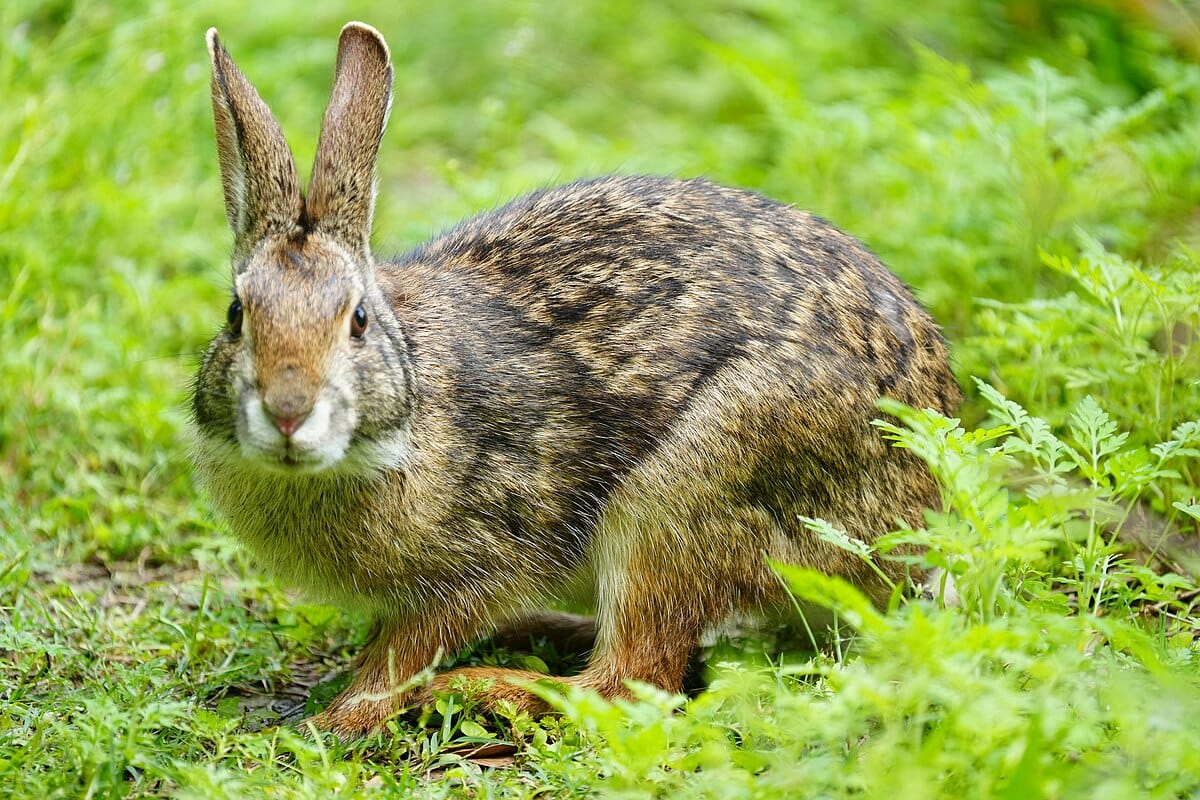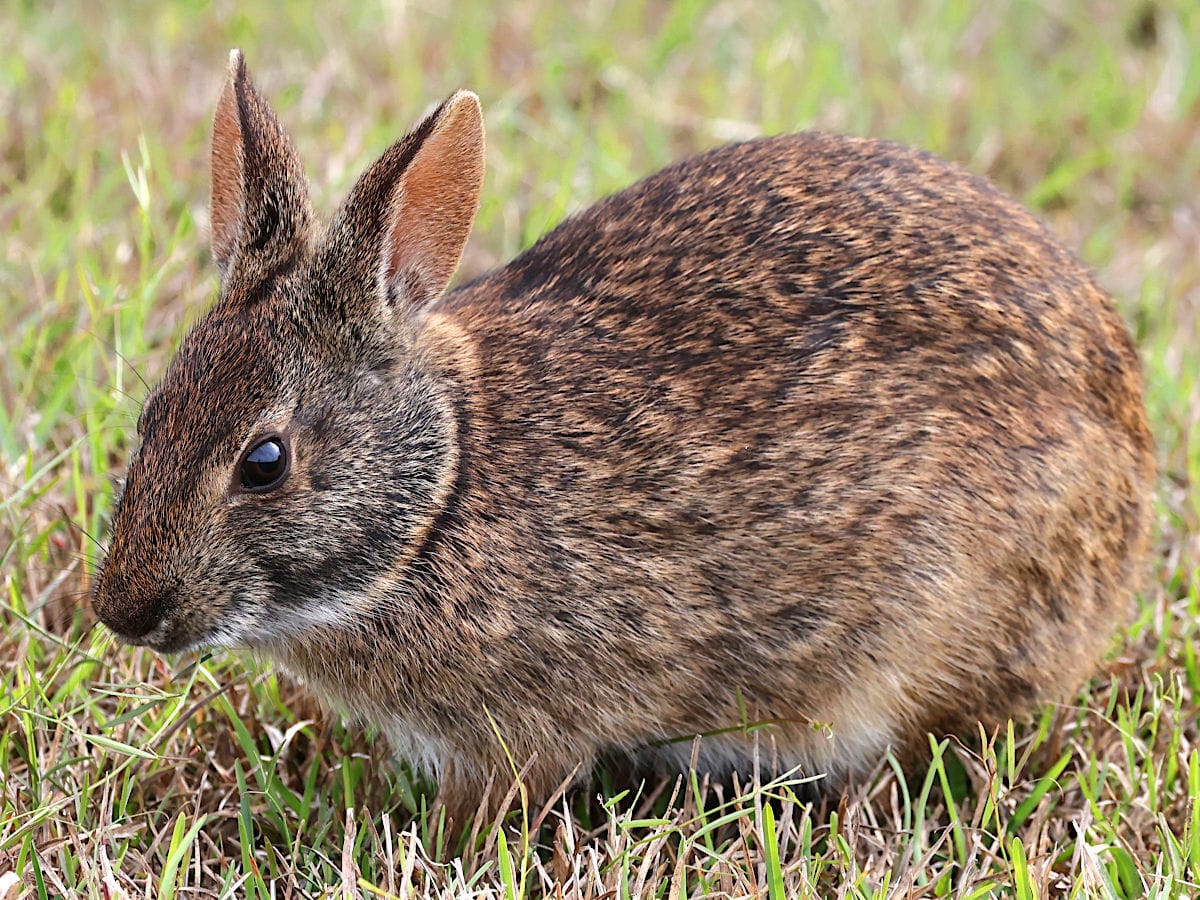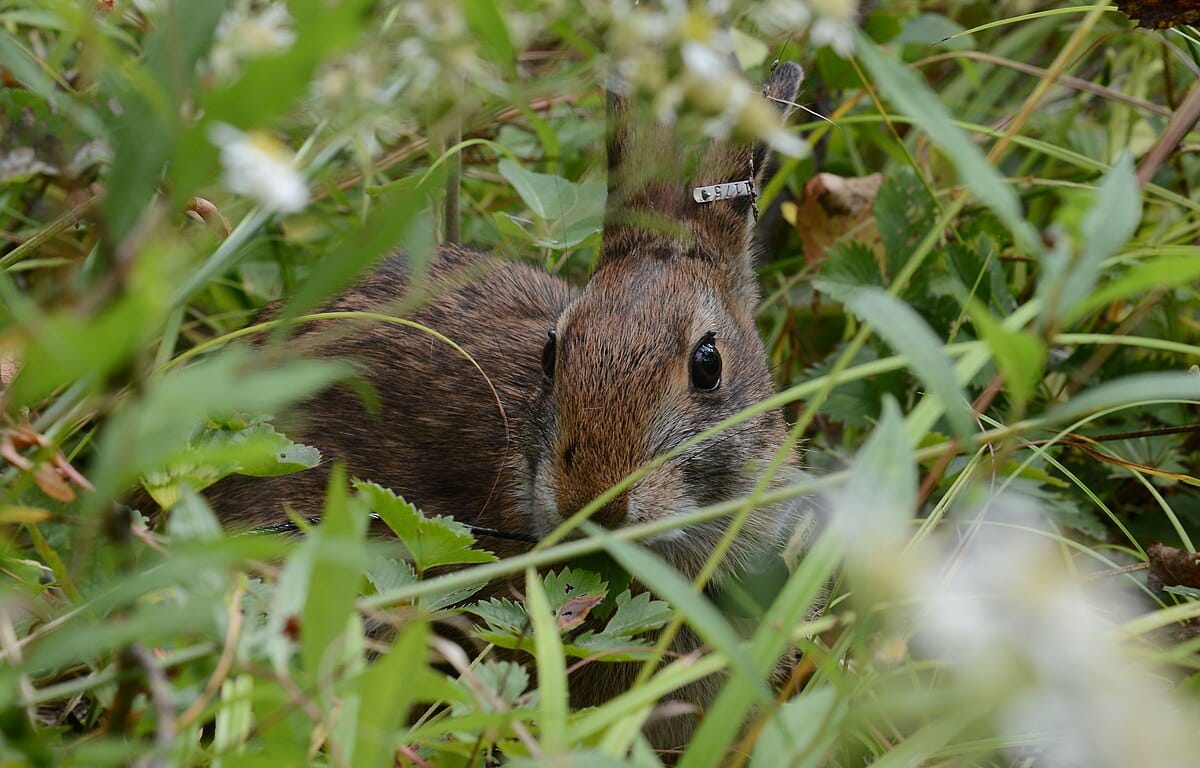Georgia is home to a fascinating variety of wild rabbits that can be spotted in forests, wetlands, fields, and even suburban backyards. In this guide, we explore the Types of Wild Rabbits in Georgia and provide detailed identification tips, behaviors, habitats, diets, and interactions with humans. Whether you are a wildlife enthusiast or just curious about the bouncy residents of Georgia, this guide will help you understand these creatures better. From the common Eastern Cottontail to the elusive Appalachian Cottontail, here’s what you need to know to spot and identify them in the wild.
1. Eastern Cottontail (Sylvilagus floridanus)

Physical Characteristics & Identification Tips
The Eastern Cottontail is Georgia’s most common rabbit. Adult cottontails range from 12 to 20 inches in length and typically weigh between 2 to 4 pounds. Their fur is a mottled brownish-gray, allowing them to blend seamlessly with grasslands and woodland edges. The tail is a distinct fluffy white, giving them their “cottontail” name. Ears are moderately long, about 2 to 4 inches, with darker tips. When observing, pay attention to the hind feet, which are large and powerful for sudden bursts of speed.
Behavior
Eastern Cottontails are primarily crepuscular, meaning they are most active during dawn and dusk. When threatened, they use a series of short, rapid hops and can sprint up to 18 mph. They often freeze when sensing danger, relying on camouflage before resorting to escape. Cottontails communicate with warning thumps of their hind legs, alerting nearby rabbits of potential predators. They are generally solitary except during breeding season.
Habitat and Range
This species thrives in open fields, forest edges, farmland, and suburban areas throughout Georgia. They prefer areas with dense cover for hiding and adjacent open spaces for foraging. Eastern Cottontails have adapted well to human-altered environments, often appearing in gardens and backyard hedges where food is abundant.
Diet
The Eastern Cottontail is herbivorous. Their diet includes grasses, clover, herbs, vegetables, bark, twigs, and buds. During winter, they rely more on woody plants and shrubs due to limited availability of fresh greens. Rabbits practice coprophagy, consuming some of their fecal pellets to extract additional nutrients.
Reproduction and Life Cycle
Breeding occurs from early spring to late fall. Females can produce 3 to 5 litters annually, with each litter containing 3 to 7 kits. Gestation lasts about 28 days. Newborns are born altricial — blind, hairless, and dependent on their mother for warmth and protection. By three weeks, kits are weaned and begin foraging near their nests. Eastern Cottontails typically live 1 to 3 years in the wild, facing high predation rates from foxes, hawks, snakes, and domestic cats.
Fun Facts / Interesting Traits
Eastern Cottontails have a unique ability to sprint in a zigzag pattern, confusing predators. They can rotate their ears almost 180 degrees to detect sounds from different directions. Despite their name, they are not true cottontails in the taxonomic sense; rather, the white tail serves as a communication and distraction tool. These rabbits are also excellent jumpers, capable of leaping up to 3 feet high and 10 feet in a single bound.
Human Interaction
Humans often encounter Eastern Cottontails in gardens, parks, and suburban yards. While they can damage crops and ornamental plants, they also play a vital role in ecosystems as prey for numerous predators. Providing brush piles or leaving natural cover in backyards can support their populations without risking property damage. Observing them quietly from a distance can offer insights into their fascinating behaviors without causing stress.
The Eastern Cottontail is a resilient and adaptable species, making it a cornerstone of Georgia’s wild rabbit population. Recognizing its physical traits, behaviors, and habitat preferences is key for anyone studying or appreciating wildlife in the region.
2. Swamp Rabbit (Sylvilagus aquaticus)

Physical Characteristics & Identification Tips
The Swamp Rabbit is one of Georgia’s largest native rabbits, measuring 16 to 22 inches long and weighing 3 to 5 pounds. Its coat is dark brown with a grayer underside, providing camouflage in swampy and wooded habitats. Unlike the Eastern Cottontail, its ears are shorter and rounded, helping it navigate dense vegetation. The tail is also white but less conspicuous. One of the easiest ways to distinguish the Swamp Rabbit is its stocky body and strong, muscular hind legs, which allow for powerful leaps and swimming capabilities.
Behavior
Swamp Rabbits are primarily nocturnal, though they may also be active at dawn or dusk. They are strong swimmers, often fleeing into water to escape predators. Unlike most cottontails, they are comfortable in wetlands and riverine habitats. They use runways through dense vegetation and are highly territorial, marking areas with droppings and scent. While generally solitary, interactions increase during the breeding season, when males actively patrol territories.
Habitat and Range
True to their name, Swamp Rabbits inhabit swamps, marshes, and bottomland forests in the southeastern U.S., including southern Georgia. They prefer areas with dense understory and accessible water sources. This species is rarely found in open fields or suburban settings, as it relies on water and cover for survival. Their habitats overlap with other rabbits, but Swamp Rabbits are uniquely adapted to wetland environments.
Diet
Swamp Rabbits are herbivores, feeding primarily on aquatic and semi-aquatic vegetation. Their diet includes grasses, sedges, water plants, leaves, twigs, and bark, especially in winter. They may also eat crops near wetlands, such as corn and soybeans. Like other rabbits, they practice coprophagy to extract extra nutrients from partially digested food.
Reproduction and Life Cycle
Breeding occurs from late winter to early summer, with females producing 1 to 3 litters annually. Each litter consists of 2 to 5 kits. The gestation period is around 35 days. Kits are born blind, hairless, and highly vulnerable, relying entirely on the mother for warmth and protection. Swamp Rabbits can live up to 4 years in the wild, though predation by foxes, raccoons, and birds of prey is common.
Fun Facts / Interesting Traits
Swamp Rabbits are excellent swimmers and have been observed crossing rivers and streams to evade predators. They can remain submerged for up to 30 seconds, using their strong legs to paddle through water. Despite their size, they move quietly through dense vegetation, making them difficult to spot. They also leave characteristic runways in marshy areas, which can help wildlife enthusiasts identify their presence.
Human Interaction
Swamp Rabbits are rarely seen in urban areas due to their preference for wetlands. They are sometimes hunted for sport in southern Georgia, and their populations are affected by wetland drainage and habitat loss. Observing these rabbits requires patience and knowledge of wetland habitats. Conserving natural swamps and floodplain forests benefits Swamp Rabbits and other wildlife that rely on these ecosystems.
3. Marsh Rabbit (Sylvilagus palustris)

Physical Characteristics & Identification Tips
Marsh Rabbits are smaller than Swamp Rabbits, typically 12 to 17 inches long and weighing 2 to 3 pounds. Their fur is dark brown to almost black on the back, with a lighter grayish belly. The ears are short and rounded, while the tail is dark on top and white underneath. These adaptations help them remain hidden in salt marshes, tidal wetlands, and dense grasses. One of their signature traits is their compact, flattened body shape, which allows them to slip easily through thick marsh vegetation.
Behavior
Marsh Rabbits are highly secretive and primarily nocturnal. They are proficient swimmers and often take to water when threatened. Unlike Eastern Cottontails, they rarely venture into open land. Their activity is influenced by tides and seasonal water levels. They are solitary for most of the year, with interactions increasing during breeding periods. When alarmed, they emit soft squeaks and thump their hind legs to warn nearby rabbits.
Habitat and Range
Marsh Rabbits inhabit coastal marshes, tidal creeks, and wetland areas along Georgia’s coastline. They are perfectly adapted to saltwater environments and rely heavily on dense grasses and shrubs for cover. These rabbits are rarely found inland, making them a unique component of Georgia’s coastal ecosystems. Protecting coastal wetlands is critical for the survival of Marsh Rabbits and the biodiversity of the region.
Diet
The diet of Marsh Rabbits includes grasses, sedges, rushes, and other marsh vegetation. They also feed on leaves, stems, and occasionally fruits from nearby shrubs. Like other rabbits, they consume soft, green vegetation during summer and rely on twigs and bark during winter. Coprophagy is practiced to extract additional nutrients from food.
Reproduction and Life Cycle
Marsh Rabbits breed year-round in mild climates like coastal Georgia. Females can produce 2 to 4 litters annually, with 2 to 6 kits per litter. Gestation lasts about 30 days. Kits are born blind and hairless, staying in hidden nests made of grass and marsh vegetation. Predation is a significant threat, especially from raccoons, alligators, and birds of prey. The average lifespan in the wild is around 3 years.
Fun Facts / Interesting Traits
Marsh Rabbits are remarkable swimmers, often using water to evade predators or move between marsh islands. They leave distinctive tracks in soft mud and can squeeze through narrow channels in tall grasses. Their coloration blends perfectly with marsh surroundings, making them almost invisible to predators. These rabbits are highly vocal for a species of their size, using soft grunts and squeaks to communicate during mating or when threatened.
Human Interaction
Marsh Rabbits are seldom seen outside of coastal wetlands, so direct human interactions are limited. They are sometimes hunted in regulated areas, and their populations are sensitive to wetland development and pollution. Conservation of salt marshes not only supports Marsh Rabbits but also a wide array of fish, birds, and other wildlife. Observing them requires patience, knowledge of tidal patterns, and quiet movement through dense marsh vegetation.
4. Appalachian Cottontail (Sylvilagus obscurus)

Physical Characteristics & Identification Tips
The Appalachian Cottontail is a medium-sized rabbit, usually 14 to 17 inches long and weighing around 2.5 to 3.5 pounds. Its fur is brownish-gray on the back with a slightly lighter belly, providing excellent camouflage among leaf litter and shrubs in forested areas. Its most distinctive feature is the small, fluffy white tail—commonly called a “cottontail.” Compared to the Eastern Cottontail, it has a slightly darker, more uniform coat and shorter ears, which helps differentiate it in the field. Its hind legs are muscular, allowing for quick bursts of speed when evading predators.
Behavior
Appalachian Cottontails are primarily crepuscular, meaning they are most active at dawn and dusk. They are highly elusive and rely on dense underbrush for shelter. Unlike some other rabbit species, they are not strong swimmers and tend to avoid open or wet habitats. They are mostly solitary except during the breeding season. When threatened, they freeze and rely on camouflage, but if discovered, they dart in zigzag patterns to escape predators like foxes, hawks, and snakes.
Habitat and Range
These rabbits are native to the Appalachian Mountains and surrounding forested regions, including northern Georgia and parts of Tennessee and West Virginia. They prefer rocky, mountainous areas with thick understory, shrubs, and fallen logs. This species avoids open fields, preferring areas where they can remain hidden from predators. Forest fragmentation and human encroachment can impact their populations, making these habitats essential for survival.
Diet
The Appalachian Cottontail is herbivorous, feeding on a variety of grasses, leaves, twigs, bark, and forest understory vegetation. During spring and summer, they favor tender shoots and green leaves, while in winter, they feed on bark, buds, and twigs. Like other rabbits, they engage in coprophagy to maximize nutrient absorption from their food.
Reproduction and Life Cycle
Breeding occurs from early spring through late summer, with females producing 2 to 3 litters per year. Each litter typically contains 3 to 5 kits. Gestation lasts about 28 days. Newborns are born blind and hairless, depending entirely on the mother for warmth and protection. Juveniles reach independence around 3 to 4 weeks old. Predation is a constant threat, and lifespan in the wild usually ranges from 1 to 3 years.
Fun Facts / Interesting Traits
The Appalachian Cottontail is well-adapted to forest life, blending seamlessly with leaf litter and rocky terrain. Unlike other rabbits, they rarely venture into open areas, making sightings uncommon. Their quiet, secretive nature allows them to survive in regions with abundant predators. They are most often detected by the characteristic tracks they leave in soft soil or snow, rather than by direct observation.
Human Interaction
Human encounters with Appalachian Cottontails are rare due to their preference for remote, mountainous forests. Habitat destruction and fragmentation can threaten populations. Hunting is limited and regulated in some areas, as this species is less abundant than other cottontails. Preserving forested habitats and limiting development in mountainous areas helps maintain healthy populations. Observing them requires patience, knowledge of forest trails, and quiet movement to avoid startling these cautious creatures.
5. New England Cottontail (Sylvilagus transitionalis)

Physical Characteristics & Identification Tips
The New England Cottontail is similar in size to the Eastern Cottontail, measuring 14 to 16 inches in length and weighing around 2.5 to 3.5 pounds. Its fur is a mix of brown, gray, and black, giving it excellent camouflage in brushy areas. The underside is lighter, usually grayish-white, and its fluffy tail is white, forming the classic “cottontail” appearance. One key distinguishing feature is its darker head and more muted coloration compared to Eastern Cottontails, helping wildlife enthusiasts and researchers tell them apart in overlapping habitats.
Behavior
New England Cottontails are secretive and mostly active during dawn and dusk. They rely heavily on dense shrubland and thickets to hide from predators like foxes, hawks, and raccoons. These rabbits are generally solitary outside of the breeding season. When threatened, they freeze first to blend with their surroundings, and if necessary, they escape with short, rapid zigzag hops. They are not strong jumpers but use quick bursts of speed and agility to evade danger.
Habitat and Range
Once widespread throughout the northeastern U.S., including parts of Georgia, New England Cottontails now inhabit fragmented areas of dense brush, young forests, and overgrown fields. They prefer habitats with thick cover and avoid open spaces. Conservation efforts focus on creating and maintaining shrubby areas to support their populations. This species is sensitive to habitat loss, and their range has shrunk significantly due to development and forest maturation without underbrush.
Diet
The diet of New England Cottontails consists primarily of grasses, herbs, leaves, twigs, and bark. In spring and summer, they favor tender shoots and green vegetation, while in winter, they rely on woody plants, buds, and bark for sustenance. Like other rabbits, they practice coprophagy, consuming soft fecal pellets to extract additional nutrients and aid digestion.
Reproduction and Life Cycle
Breeding occurs from early spring through late fall, with females producing 2 to 3 litters per year. Each litter contains 3 to 6 kits, which are born blind and hairless. Young rabbits become independent after about 3 to 4 weeks. Predation is a major threat, and most New England Cottontails live only 1 to 3 years in the wild. Habitat quality directly affects reproductive success, as dense cover is crucial for raising young safely.
Fun Facts / Interesting Traits
New England Cottontails are considered a “shadow species” because they are so elusive and rarely seen, even in suitable habitats. They play a vital role in the ecosystem, serving as prey for numerous predators and contributing to plant community dynamics through their feeding habits. Their population declines have made them a focus of conservation efforts across several states, emphasizing habitat restoration and monitoring programs.
Human Interaction
Human activity impacts New England Cottontails primarily through habitat destruction and fragmentation. Conservation programs work to create suitable thickets and brushy areas to help populations recover. Hunting is minimal and regulated, as the species is less abundant than other cottontails. Observing these rabbits requires patience, careful movement, and familiarity with their preferred shrubby habitats. Public awareness and habitat protection are crucial for maintaining healthy populations.
Conclusion
Georgia is home to a fascinating variety of wild rabbits, including the Eastern Cottontail, Appalachian Cottontail, Swamp Rabbit, and New England Cottontail. Each species has its own distinct traits, behaviors, and habitat preferences, from forested mountains to marshy lowlands. Observing these creatures provides a window into the natural world and highlights the importance of preserving their habitats. Understanding their diet, reproduction, and interactions with humans can help communities coexist with these charming animals while supporting conservation efforts.
Whether you’re a wildlife enthusiast, a backyard observer, or simply curious about nature, learning about the Types of Wild Rabbits in Georgia adds depth to your outdoor experiences. Protecting their environments ensures that these rabbits continue to thrive and enrich Georgia’s ecosystems for generations to come. Keep exploring, stay respectful of wildlife, and enjoy watching these incredible animals in their natural surroundings.
Frequently Asked Questions About Wild Rabbits in Georgia
1. What are the most common types of wild rabbits in Georgia?
The most common wild rabbits in Georgia include the Eastern Cottontail, Appalachian Cottontail, Swamp Rabbit, and New England Cottontail. Each species prefers different habitats, such as forests, wetlands, and brushy areas.
2. How can I identify an Eastern Cottontail?
Eastern Cottontails are medium-sized, with brownish-gray fur and a characteristic white underside on their tail. They are often found in fields, gardens, and forest edges.
3. What makes the Appalachian Cottontail different from the Eastern Cottontail?
The Appalachian Cottontail is smaller, with darker fur and a shorter tail. It primarily inhabits higher elevations and dense forested areas, unlike the more common Eastern Cottontail.
4. Where do Swamp Rabbits live in Georgia?
Swamp Rabbits prefer wetland habitats, including swamps, marshes, and river floodplains. They are strong swimmers and are rarely found far from water.
5. What is unique about the New England Cottontail?
New England Cottontails are elusive and shy. They require dense shrubs and thickets for cover, and their populations have declined due to habitat loss, making conservation efforts important.
6. Are wild rabbits active during the day or night?
Most wild rabbits are crepuscular, meaning they are most active during dawn and dusk. This helps them avoid predators while foraging.
7. What do wild rabbits in Georgia eat?
Wild rabbits primarily eat grasses, leaves, herbs, twigs, and bark. Their diet changes seasonally; in winter, they may feed on buds and woody plants.
8. How do rabbits reproduce?
Rabbits breed from early spring to late fall. Females can have multiple litters per year, each with 3–6 kits. The young are born blind and hairless, becoming independent in about 3–4 weeks.
9. How long do wild rabbits live in Georgia?
In the wild, most rabbits live 1–3 years due to predation and environmental challenges. Some may live longer in protected areas.
10. What predators threaten wild rabbits?
Common predators include foxes, hawks, owls, raccoons, bobcats, and domestic cats and dogs. Rabbits rely on camouflage, quick escapes, and dense cover for survival.
11. Do wild rabbits hibernate in winter?
No, wild rabbits remain active year-round. They adapt by eating woody plants, buds, and bark when fresh vegetation is scarce.
12. How do rabbits communicate?
Rabbits use body language, thumping their hind legs to signal danger, and scent markings to define territory. Vocalizations are rare but include squeals or grunts when alarmed.
13. Can wild rabbits swim?
Swamp Rabbits are excellent swimmers and can cross rivers or marshy areas. Other species, like Eastern and Appalachian Cottontails, generally avoid water but can wade through shallow streams.
14. Are wild rabbits aggressive to humans?
No, wild rabbits are generally shy and avoid human contact. They may flee when approached but do not typically attack unless cornered or threatened.
15. How can I attract rabbits to my backyard?
Provide a safe habitat with shrubs, native grasses, and brush piles. Avoid chemicals and predators. Access to fresh water also helps attract rabbits.
16. How do rabbits help the ecosystem?
Rabbits serve as prey for predators and help control vegetation. Their grazing influences plant growth, and their droppings enrich soil nutrients.
17. What is coprophagy, and do rabbits practice it?
Coprophagy is when rabbits eat some of their soft fecal pellets to extract additional nutrients. This is normal and vital for their digestion.
18. How can I tell a Swamp Rabbit from an Eastern Cottontail?
Swamp Rabbits are larger, darker, and have a more robust body. They live near water and are capable swimmers, unlike the more terrestrial Eastern Cottontail.
19. Can rabbits damage gardens?
Yes, rabbits may eat vegetables, flowers, and shrubs. Garden fencing, repellents, and protective covers can help reduce damage.
20. Are rabbits social animals?
Most wild rabbits are solitary or live in small groups. Social behavior is limited to breeding or family units during early life stages.
21. How do rabbits escape predators?
Rabbits use zigzag running, freezing, and hiding in dense cover. Their camouflage and alert senses are their main defenses.
22. What is the ideal habitat for New England Cottontails?
They require thick, shrubby areas with plenty of underbrush for cover. Open fields and mature forests without undergrowth are not suitable for them.
23. Do wild rabbits carry diseases?
Rabbits can carry parasites, ticks, and, rarely, diseases like tularemia. However, transmission to humans is uncommon. Avoid direct contact or handling.
24. How do rabbits survive cold winters?
Rabbits grow a thicker winter coat, rely on woody plants and buds, and seek shelter in dense brush or burrows for warmth.
25. What are some fun facts about rabbits?
Rabbits can run up to 18 mph, have nearly 360-degree vision, and can rotate their ears to detect sounds. Their powerful hind legs are designed for quick escapes.
26. How can I observe rabbits without disturbing them?
Stay quiet, use binoculars, and avoid direct approaches. Observing from a distance during dawn or dusk increases chances of seeing natural behavior.
27. Do rabbits make nests?
Yes, female rabbits dig shallow nests called “forms” lined with fur and grass for their young. The nests are usually hidden in dense vegetation.
28. How do human developments affect wild rabbits?
Urbanization, road construction, and clearing land reduce available habitat, forcing rabbits into fragmented areas and increasing predation risk.
29. Are any wild rabbits in Georgia endangered?
The New England Cottontail is rare and declining due to habitat loss. Conservation efforts focus on restoring shrubby habitats to support their populations.
30. Can wild rabbits coexist with pets?
Wild rabbits generally avoid pets, but domestic cats and dogs can be a threat. Keeping pets indoors or under supervision helps rabbits stay safe.
31. What time of year is best to see wild rabbits?
Spring and early summer are ideal, as vegetation is abundant and rabbits are more active foraging and breeding. Dawn and dusk are the best times of day for observation.
32. How do rabbits impact gardens and agriculture?
Rabbits feed on young crops, vegetables, and ornamental plants. Protective barriers, netting, and repellents can help mitigate damage without harming the animals.
33. Can rabbits adapt to urban environments?
Yes, some species like Eastern Cottontails can live in suburban areas with gardens, parks, and green spaces, as long as cover and food are available.
Read more: 3 Types of Wild Rabbits in Ohio: Species, Identification, and Photos
